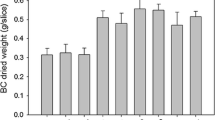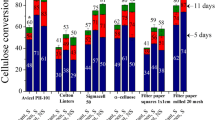Abstract
Bacterial cellulose (BC) production culture requires high oxygen transfer rate (representatively k L a) at a low shear force. Considering that oxygen exhaustion is observed at the latter half of the exponential growth phase where BC production actually begins, it is highly probable that the drastic reduction of k L a (oxygen volumetric transfer coefficient) is caused by the drastic increase of the soluble and insoluble viscous materials. Therefore, we examined the apparent viscosity-inducing materials generated during BC culture and investigated their effects on k L a. Using the saccharified liquid from food waste as the culture medium, we discussed the relationship between the concentration of the generated solid matters, especially BC and the viscosity, the relationship between the BC concentration and k L a, and the correlation between the viscosity and k L a. The relationship between the solid matter (BC), which is the insoluble viscosity-inducing material, and k L a showed that the BC concentration and k L a were in exponentially reciprocal proportion with the linear regression equation. In case of using agar as the soluble viscosity-inducing material, the correlation between the viscosity and k L a showed that the viscosity depending on the agar concentration was in exponentially reciprocal proportion with k L a in both tap water and the saccharified liquid medium. The results indicated that the effect of the BC concentration on k L a was not great in the saccharified liquid medium. As the agar concentration increased in tap water and the saccharified liquid medium, the viscosity was increased and k L a was decreased gradually, showing a linear relation between the logarithm of the viscosity as agar and k L a. In conclusion, the effect of the soluble viscosity on k L a was greater than that of solid matter (BC). Also, it was suggested that the soluble viscosity-inducing matters like agar were rather more effective than k L a in BC production.
Similar content being viewed by others
References
J. Rainer and F. F. Luiz, Polym. Degrad. Stabil., 58, 101 (1998).
S. Yamanake and K. Watanabe, Applications of bacterial cellulose in cellulosic polymers, in R. Gillbert (Ed.), Cellulosic Polymers, Blends and Composites, Hanser Inc., Cincinnati, OH, USA (1995).
C. N. Choi, H. J. Song, M. J. Kim, M. H. Chang and S. J. Kim, Korean J. Chem. Eng., 26(1), 136 (2009).
R. E. Cannon and S.M. Anderson, Crit. Rev. Microbiol., 17, 435 (1991).
D. Klemm, D. Schumann, U. Udhard and S. Marsch, Prog. Polym. Sci., 26, 1561 (2001).
S. H. Moon, J.M. Park, H.Y. Chun and S. J. Kim, Biotechnol. Bioprocess. Eng., 11, 26 (2006).
S. Keshk and K. Sameshima, Enzyme Microb. Technol., 40, 4 (2006).
H. Feng and K. Qiu. Carbohyd. Polym., 72, 545 (2008).
T. Kouda, H. Yano and F. Yoshinaga, J. Ferment. Bioeng., 83(4), 371 (1997).
H. J. Son, H.G. Kim, K.K. Kim, H. S. Kim, Y.G. Kim and S. J. Lee, Bioresour. Technol., 86, 215 (2003).
Y. Chao, T. Ishida, Y. Sugano and M. Shoda, Biotechnol. Bioeng., 68(3), 345 (2000).
O. Shezad, S. Khan, T. Khan and J. K. Park, Korean J. Chem. Eng., 26(6), 1689 (2009).
S. Valla and J. Kjosbakken, J. Gen. Microbiol., 128, 1401 (1982).
J. E. Lee, C. H. Jung and S. J. Kim, Differential expression of membrane proteins in cel(+) and cel(−) strains of Acetobacter xylinum KJ1, Korean Society for Biochemistry and Molecular Biology, 62nd Annual Meeting, May 19–20, Seoul, Korea (2005).
Y. Chao, M. Mitarai, Y. Sugano and M. Shoda, Biotechnol. Progr., 17, 781 (2001).
S. O. Bae, Y. Sugano and M. Shoda, J. Biosci. Bioeng., 97(1), 33 (2004).
T. Ishida, Y. Sugano, T. Nakai and M. Shoda, Biosci. Biotechnol. Biochem., 66(8), 1677 (2002).
H. J. Song, H. Li, J. H. Seo, M. J. Kim and S. J. Kim, Korean J. Chem. Eng., 26(1), 141 (2009).
F. J. Montes, J. Catalan and M. A. Galan, Process. Biochem., 34, 549 (1998).
C. M. Tuffile and F. Pinho, Biotechnol. Bioeng., 12, 849 (1970).
F. Garæia-Ochoa, E. Gõmez Castro and V. E. Santos, Enzyme Microb. Technol., 27, 680 (2000).
P. A. Gibbs and R. J. Seviour, Appl. Microbiol. Biot, 46, 503 (1996).
S. Miura, T. Arimura, M. Hoshino, M. Kojima, L. Dwiarti and M. Okabe, J. Biosci. Bioeng., 96(1), 65 (2003).
C. Bandaiphet and P. Prasertsan, Carbohyd. Polym., 66, 216 (2006).
B. Özbck and S. Gayik, Process. Biochem., 36, 729 (2001).
R. I. Carbajal and A. Tecante, Biochem. Eng. J., 18, 185 (2004).
Author information
Authors and Affiliations
Corresponding author
Rights and permissions
About this article
Cite this article
Kim, S., Li, H., Oh, I. et al. Effect of viscosity-inducing factors on oxygen transfer in production culture of bacterial cellulose. Korean J. Chem. Eng. 29, 792–797 (2012). https://doi.org/10.1007/s11814-011-0245-8
Received:
Accepted:
Published:
Issue Date:
DOI: https://doi.org/10.1007/s11814-011-0245-8




